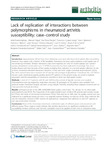Lack of replication of interactions between polymorphisms in rheumatoid arthritis susceptibility: case–control study

View/
Use this link to cite
http://hdl.handle.net/2183/25311Collections
- Investigación (FCS) [1293]
Metadata
Show full item recordTitle
Lack of replication of interactions between polymorphisms in rheumatoid arthritis susceptibility: case–control studyAuthor(s)
Date
2014-09-27Citation
Ferreiro-Iglesias A, Calaza M, Pérez-Pampin E, López LOngo FJ, Marenco JL, Blanco FJ, et al. Lack of replication of interactions between polymorphisms in rheumatoid arthritis susceptibility: case–control study. Arthritis Res Ther. 2014;16(5): 436
Abstract
[Abstract] INTRODUCTION:
Approximately 100 loci have been definitively associated with rheumatoid arthritis (RA) susceptibility. However, they explain only a fraction of RA heritability. Interactions between polymorphisms could explain part of the remaining heritability. Multiple interactions have been reported, but only the shared epitope (SE) × protein tyrosine phosphatase nonreceptor type 22 (PTPN22) interaction has been replicated convincingly. Two recent studies deserve attention because of their quality, including their replication in a second sample collection. In one of them, researchers identified interactions between PTPN22 and seven single-nucleotide polymorphisms (SNPs). The other showed interactions between the SE and the null genotype of glutathione S-transferase Mu 1 (GSTM1) in the anti-cyclic citrullinated peptide-positive (anti-CCP+) patients. In the present study, we aimed to replicate association with RA susceptibility of interactions described in these two high-quality studies.
METHODS:
A total of 1,744 patients with RA and 1,650 healthy controls of Spanish ancestry were studied. Polymorphisms were genotyped by single-base extension. SE genotypes of 736 patients were available from previous studies. Interaction analysis was done using multiple methods, including those originally reported and the most powerful methods described.
RESULTS:
Genotypes of one of the SNPs (rs4695888) failed quality control tests. The call rate for the other eight polymorphisms was 99.9%. The frequencies of the polymorphisms were similar in RA patients and controls, except for PTPN22 SNP. None of the interactions between PTPN22 SNPs and the six SNPs that met quality control tests was replicated as a significant interaction term--the originally reported finding--or with any of the other methods. Nor was the interaction between GSTM1 and the SE replicated as a departure from additivity in anti-CCP+ patients or with any of the other methods.
CONCLUSIONS:
None of the interactions tested were replicated in spite of sufficient power and assessment with different assays. These negative results indicate that whether interactions are significant contributors to RA susceptibility remains unknown and that strict standards need to be applied to claim that an interaction exists.
Keywords
Arthritis rheumatoid
Case-control studies
Chi-square distribution
Epistasis
Genetic predisposition to disease
Genotype
Glutathione transferase
HLA-DRB1 chains
Polymorphism
Protein tyrosine phosphatase
Genetic
Single nucleotide
Non-receptor type 22
Case-control studies
Chi-square distribution
Epistasis
Genetic predisposition to disease
Genotype
Glutathione transferase
HLA-DRB1 chains
Polymorphism
Protein tyrosine phosphatase
Genetic
Single nucleotide
Non-receptor type 22
Editor version
Rights
Atribución 3.0 España
ISSN
1478-6354






